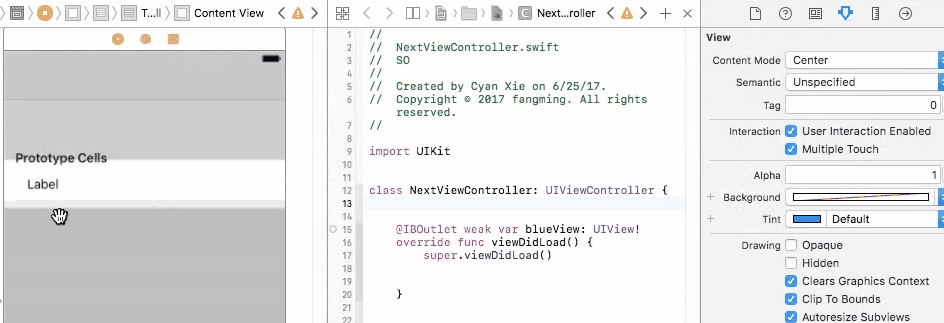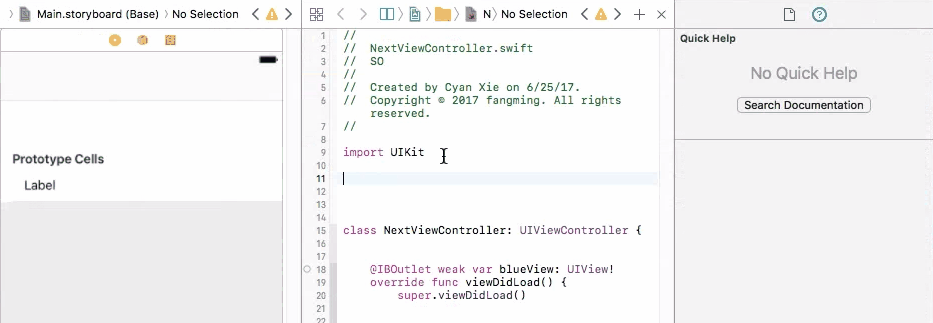Outlets cannot be connected to repeating content iOS
IosStoryboardIos Problem Overview
I have just created an app and have started hooking up @IBOutlet's to the storyboard. I am connecting some of them to labels in a UITableViewCell Prototype Cell with a Basic Style. When I connect it though I get this error in the Storyboard:
> The detailText Outlet from the TableViewController to the UILabel is invalid. Outlets cannot be connected to repeating content.
Can someone help me out? I have set it up the way I always do successfully but this time it has chucked me this error.
Ios Solutions
Solution 1 - Ios
Create a table view cell subclass and set it as the class of the prototype. Add the outlets to that class and connect them. Now when you configure the cell you can access the outlets.
Solution 2 - Ios
There are two types of table views cells provided to you through the storyboard, they are Dynamic Prototypes and Static Cells
1. Dynamic Prototypes
From the name, this type of cell is generated dynamically. They are controlled through your code, not the storyboard. With help of table view's delegate and data source, you can specify the number of cells, heights of cells, prototype of cells programmatically.
When you drag a cell to your table view, you are declaring a prototype of cells. You can then create any amount of cells base on this prototype and add them to the table view through cellForRow method, programmatically. The advantage of this is that you only need to define 1 prototype instead of creating each and every cell with all views added to them by yourself (See static cell).
So in this case, you cannot connect UI elements on cell prototype to your view controller. You will have only one view controller object initiated, but you may have many cell objects initiated and added to your table view. It doesn't make sense to connect cell prototype to view controller because you cannot control multiple cells with one view controller connection. And you will get an error if you do so.
To fix this problem, you need to connect your prototype label to a UITableViewCell object. A UITableViewCell is also a prototype of cells and you can initiate as many cell objects as you want, each of them is then connected to a view that is generated from your storyboard table cell prototype.
Finally, in your cellForRow method, create the custom cell from the UITableViewCell class, and do fun stuff with the label
override func tableView(_ tableView: UITableView, cellForRowAt indexPath: IndexPath) -> UITableViewCell {
let cell = tableView.dequeueReusableCell(withIdentifier: "yourCellIdentifier") as! YourCell
cell.label.text = "it works!"
return cell
}
2. Static Cells
On the other hand, static cells are indeed configured though storyboard. You have to drag UI elements to each and every cell to create them. You will be controlling cell numbers, heights, etc from the storyboard. In this case, you will see a table view that is exactly the same from your phone compared with what you created from the storyboard. Static cells are more often used for setting page, which the cells do not change a lot.
To control UI elements for a static cell, you will indeed need to connect them directly to your view controller, and set them up.
Solution 3 - Ios
If you're using a table view to display Settings and other options (like the built-in Settings app does), then you can set your Table View Content to Static Cells under the Attributes Inspector. Also, to do this, you must embedded your Table View in a UITableViewController instance.
Solution 4 - Ios
Or you don't have to use IBOutlet to refer to the object in the view. You can give the Label in the tableViewCell a Tag value, for example set the Tag to 123 (this can be done by the attributes inspector). Then you can access the label by
override func tableView(_ tableView: UITableView, cellForRowAt indexPath: IndexPath) -> UITableViewCell {
let cell = tableView.dequeueReusableCell(withIdentifier: "someID", for: indexPath)
let label = cell.viewWithTag(123) as! UILabel //refer the label by Tag
switch indexPath.row {
case 0:
label.text = "Hello World!"
default:
label.text = "Default"
}
return cell
}
Solution 5 - Ios
With me I have a UIViewcontroller, and into it I have a tableview with a custom cell on it. I map my outlet of UILabel into UItableviewcell to the UIViewController then got the error.
Solution 6 - Ios
As most people have pointed out that subclassing UITableViewCell solves this issue.
But the reason this not allowed because the prototype cell(UITableViewCell) is defined by Apple and you cannot add any of your own outlets to it.
Solution 7 - Ios
Sometimes Xcode could not control over correctly cell outlet connection.
Somehow my current cell’s label/button has connected another cell I just remove those and error goes away.
Solution 8 - Ios
For collectionView :
solution:
> From viewcontroller, kindly remove the IBoutlet of colllectionviewcell
. the issue mentions the invalid of your IBOutlet. so remove all subclass which has multi-outlet(invalids) and reconnect it.
The answer is already mentioned in another question for collectionviewcell
Solution 9 - Ios
Click on simulator , Navigate to Window and enable Device Bezels



